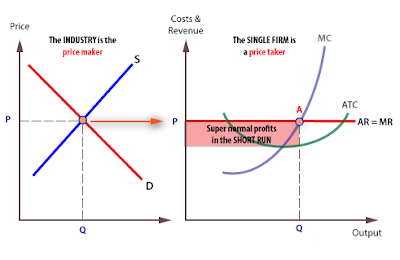Competitive Market
A competitive market is one in which a large numbers of buyers and sellers. In a competitive market no single producer, or group of producers, and no single consumer, or group of consumers. All firms sell an identical product,and all firms are price takers - they cannot control the market price of their product. The industry is characterized by freedom of entry and exit.
Sellers must take the existing market price; if in competitive market one seller set a price above the market price, no one will buy their product because potential buyers easily will go to other suppliers. Setting a price below the market price does not make any sense because the firm can sell as much as it wants to at the market price; selling below the market price will just reduce profits.
Because sellers must take the existing market price a perfect competitive market is also called a "price takers" market.
The firm can sell as much as it can produce at the existing market price, so demand is not a constraint for the firm. Revenue will be simply the market price multiplied by quantity produced.
Sellers must take the existing market price; if in competitive market one seller set a price above the market price, no one will buy their product because potential buyers easily will go to other suppliers. Setting a price below the market price does not make any sense because the firm can sell as much as it wants to at the market price; selling below the market price will just reduce profits.
The firm can sell as much as it can produce at the existing market price, so demand is not a constraint for the firm. Revenue will be simply the market price multiplied by quantity produced.
Short-Run Supply
In determining how much output to supply, the firm's objective is to maximize profits subject to two constraints: the consumers' demand for the firm's product and the firm's costs of production. Consumer demand determines the price at which a perfectly competitive firm may sell its output. The costs of production are determined by the technology the firm uses. The firm's profits are the difference between its total revenues and total costs.
total revenue (TR) will be simply P × Q, where P = price and Q = quantity sold.
Marginal revenue (MR), the increase in total revenue for production of one additional unit, will always be equal to the market price for a price taker.
Marginal costs (MC) will vary, depending upon the quantity produced. We would expect the firm to increase input up to the point where marginal cost is equal to the market price. In the short run, a firm will produce as long as its average variable costs (AVC) do not exceed the market price. If the market price is less than the firm's total average cost, but greater than its average variable cost, then the firm will still operate in the short run. Its losses will be lowered by producing, since nothing can be done about fixed costs in the short run. Over the long run, the firm will need to cover all of it costs if it is to keep on producing.
In determining how much output to supply, the firm's objective is to maximize profits subject to two constraints: the consumers' demand for the firm's product and the firm's costs of production. Consumer demand determines the price at which a perfectly competitive firm may sell its output. The costs of production are determined by the technology the firm uses. The firm's profits are the difference between its total revenues and total costs.
total revenue (TR) will be simply P × Q, where P = price and Q = quantity sold.
Marginal revenue (MR), the increase in total revenue for production of one additional unit, will always be equal to the market price for a price taker.
Marginal revenue (MR), the increase in total revenue for production of one additional unit, will always be equal to the market price for a price taker.
Marginal costs (MC) will vary, depending upon the quantity produced. We would expect the firm to increase input up to the point where marginal cost is equal to the market price. In the short run, a firm will produce as long as its average variable costs (AVC) do not exceed the market price. If the market price is less than the firm's total average cost, but greater than its average variable cost, then the firm will still operate in the short run. Its losses will be lowered by producing, since nothing can be done about fixed costs in the short run. Over the long run, the firm will need to cover all of it costs if it is to keep on producing.
Equilibrium in perfect competition
In the short run
Under perfect competition, firms can make super-normal profits or losses.

Competitive Market - online classes for economics, statistics
Under perfect competition, firms can make super-normal profits or losses.
 |
| Competitive Market - online classes for economics, statistics |







0 comments:
Post a Comment